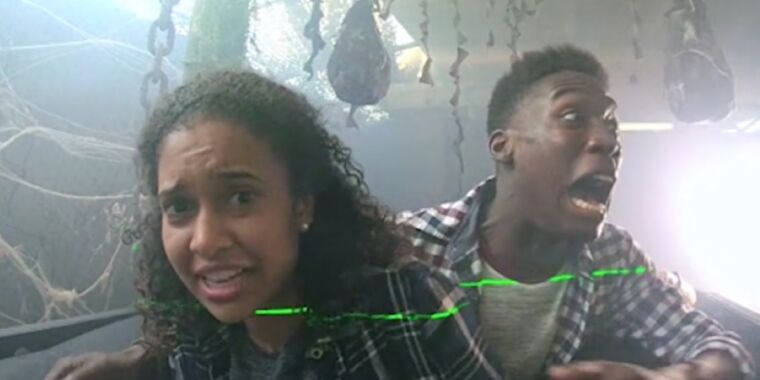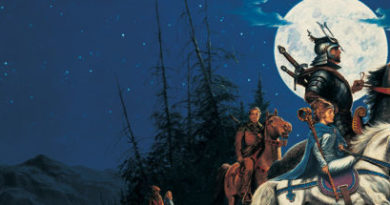New haunted house study suggests there’s a sweet spot for recreational fear
[ad_1]
Haunted houses can be chilling delights, but a new study accepted for publication in the journal Psychological Science shows that to be truly enjoyable, they should not be too terrifying or too tame.
Fear is typically viewed as a negative emotion, an adverse reaction to keep us on our toes with regard to potential dangers in our environment. But human beings also tend to seek out scary movies, horror novels, or haunted houses—and not just during the Halloween season. This tendency has been dubbed “recreational fear” in the academic literature: a “mixed emotional experience of fear and enjoyment.” But the scare factor has to be just right in order to achieve that mixed state, according to a new paper in the journal Psychological Science that correlates this “Goldilocks zone” of subjective enjoyment with a telltale range of heart-rate fluctuations.
“By investigating how humans derive pleasure from fear, we find that there seems to be a ‘sweet spot’ where enjoyment is maximized,” said co-author Marc Malmdorf Andersen, a researcher at the Interacting Minds Center at Denmark’s Aarhus University. “Our study provides some of the first empirical evidence on the relationship between fear, enjoyment, and physical arousal in recreational forms of fear.”
This is just the latest development in a course of research spearheaded by Mathias Clasen of Aarhus University, another co-author and the author of Why Horror Seduces. For instance, Clasen has examined the dominant personality traits of horror fans. (They tend to score highly on openness to experience, also called intellect imagination.) And last year we reported on his investigation of two different fear-regulation strategies employed by subjects participating in a Danish haunted house: “adrenaline junkies,” who lean into the fear, and “white-knucklers,” who try to tamp down their fear. A third study still in progress will examine the relationship between fear and memory.
Movies and houses
Clasen’s core hypothesis—that horror exploits the evolved fear system—received a boost earlier this year from a study by scientists at the University of Turku in Finland. They used an MRI to map the neural activity of subjects while the subjects watched horror movies: specifically, the 2010 film Insidious and 2016’s The Conjuring 2. Participants rated their fear levels throughout both films.
As we reported previously, the Finnish study focused on two types of fear: that creeping sense of foreboding in a spooky setting, with a growing sense that something is not quite right, and the instinctive jolting response we have to an unexpected sudden appearance of a monster or other threat (a jump scare). The team found that during the former scenarios, there are marked increases in brain activity in terms of visual and auditory perception. In the sudden shock scenarios, there was heightened brain activity in regions involved in processing emotion, evaluating threats, and making decisions, the better to respond rapidly to any perceived threats.
This latest study is based on analysis of data gleaned from a 2017 experiment at the annual Dystopia haunted house in Vejle, Denmark, a commercial attraction with 42 thematically connected rooms, providing an immersive, live-action horror experience. Housed in an old fish factory and run by a group of horror enthusiasts, as many as 300 volunteers pitch in for the entire month of October each year. The Aarhus researchers strapped heart-rate monitors onto the participants and outfitted several of the haunted-house rooms with infrared cameras. That way they could measure heart rates and also track posture and facial expressions. Participants completed questionnaires before and after their haunted house experience.
-
Researchers interested in studying “recreational fear” have found haunted house attractions to be an invaluable real-world “laboratory.”
-
Members of the Aarhus University Horror Research Team.
Vimeo/APA -
Freeze-frames from surveillance-camera footage at the first jump-scare location, involving a concealed zombie.
M.M. Andersen et al. -
Run away! Run away!
Vimeo/APA -
An ominous figure lurks in the shadows.
Vimeo/APA -
Flee the chainsaw-wielding Pig-Man!
Vimeo/APA -
Participants found the experience scary but also fun.
Vimeo/APA
The team focused on three locations in the haunted house. In the first, participants met a mad scientist, who embarked on a long monologue before kicking over a bucket—the cue for a zombie to jump out and frighten the participants. The second involved a combustion engine igniting, cueing the appearance of a large man in a pig’s mask and a bloody butcher’s apron (he pursued participants with a chainsaw). Finally, just before the exit, participants would turn a corner and unexpectedly encounter a horde of snarling zombies.
“The hypothesis is that there’s a sweet spot between too much fear and not enough fear, between predictability and unpredictability, where you feel you have a certain amount of control over the situation, but there’s still a degree of unpredictability,” Clasen told Ars last year. And the results largely support that hypothesis. When Clasen’s team plotted the relationship between levels of self-reported fear and enjoyment by participants in the experiment, the data showed an inverted U-shape—a Goldilocks zone for maximum enjoyment. There was a similar U-shaped trend in the data for participants’ heart-rate signatures.
“This is strikingly similar to what scientists have found to characterize human play,” said Andersen. “We know, for instance, that curiosity is often aroused when individuals have their expectations violated to a just-right degree, and several accounts of play stress the importance of just-right doses of uncertainty and surprise for explaining why play feels enjoyable.”
Caveats
As always, there are some caveats, such as whether the behavioral measures used (facial expression and body language) are the best approach for that metric. Future studies might employ behavioral proxies—perhaps using accelerometers to track participants’ movements in response to jump scares. The authors acknowledged numerous methodological challenges, which contributed to a relatively high number of excluded participants (18 out of 110). Specifically, people in the haunted house often bumped into each other, made sudden movements, or even broke out into sweats, all of which occasionally interfered with signal detection from the heart-rate monitors worn by participants.
There were also several participants who were distracted enough by the carnival-like atmosphere of the haunted house waiting area to forget to fill out the requisite questionnaires. And the authors also acknowledged that they can’t yet determine whether these findings generalize beyond the haunted house setting to other media like horror films, horror novels, or even roller coasters or extreme sports.
Nonetheless, “Our findings of how fear and enjoyment coexist on subjective and physiological levels are intriguing,” the authors concluded, calling for future studies to replicate their findings. “For now, understanding recreational horror as a form of play seems to be a fruitful approach to a longstanding paradox in the psychology of fear.”
DOI: Psychological Science, 2020. 10.1177/0956797620972116 (About DOIs).
Listing image by Vimeo/APA
[ad_2]
Source link




